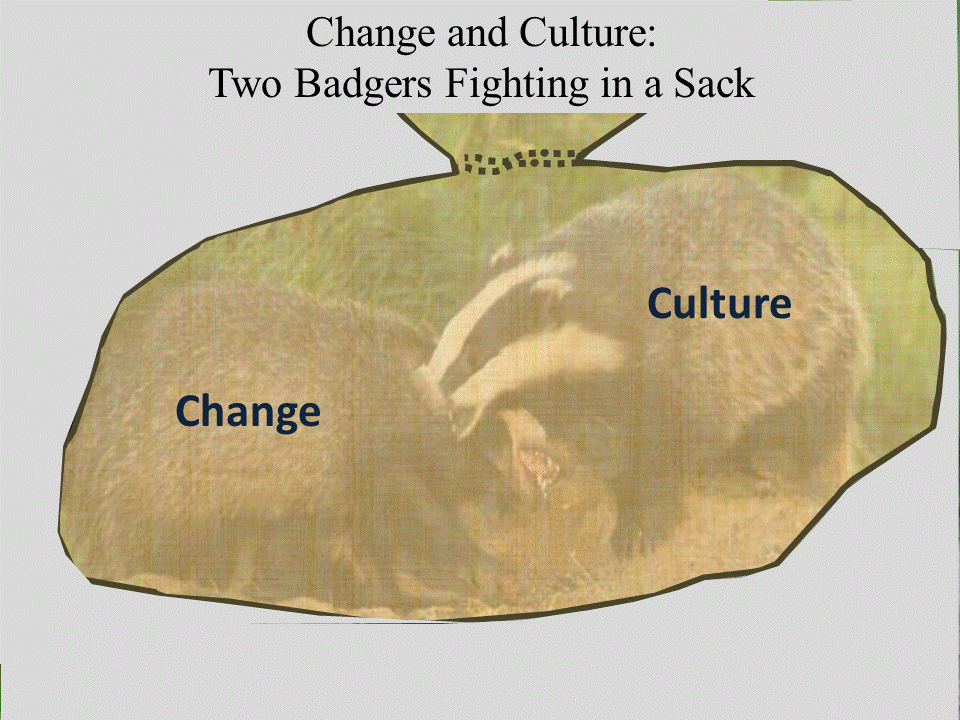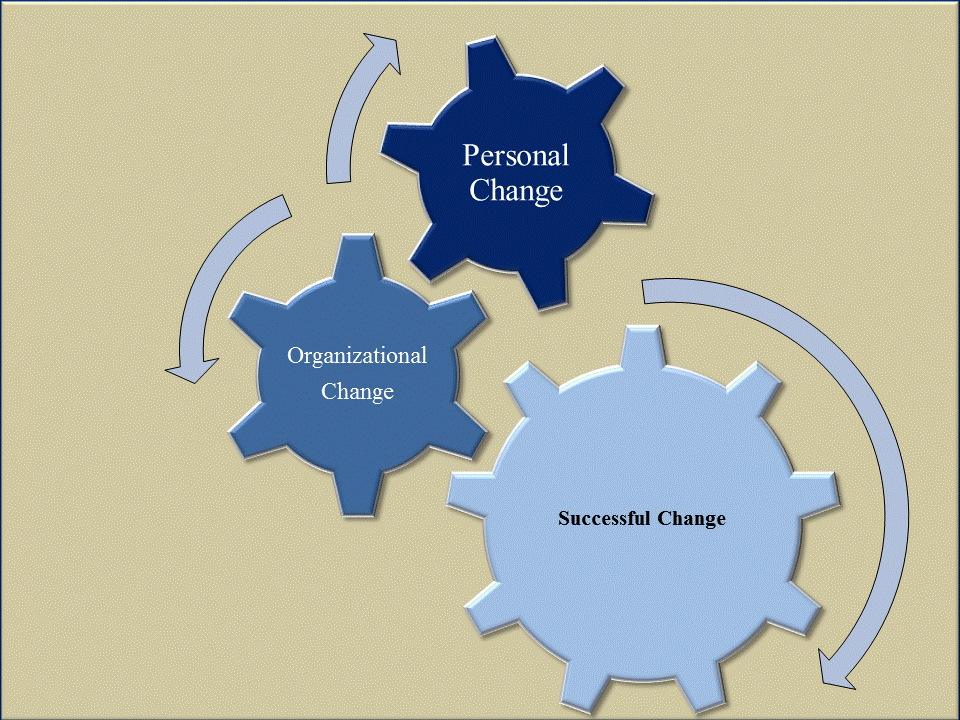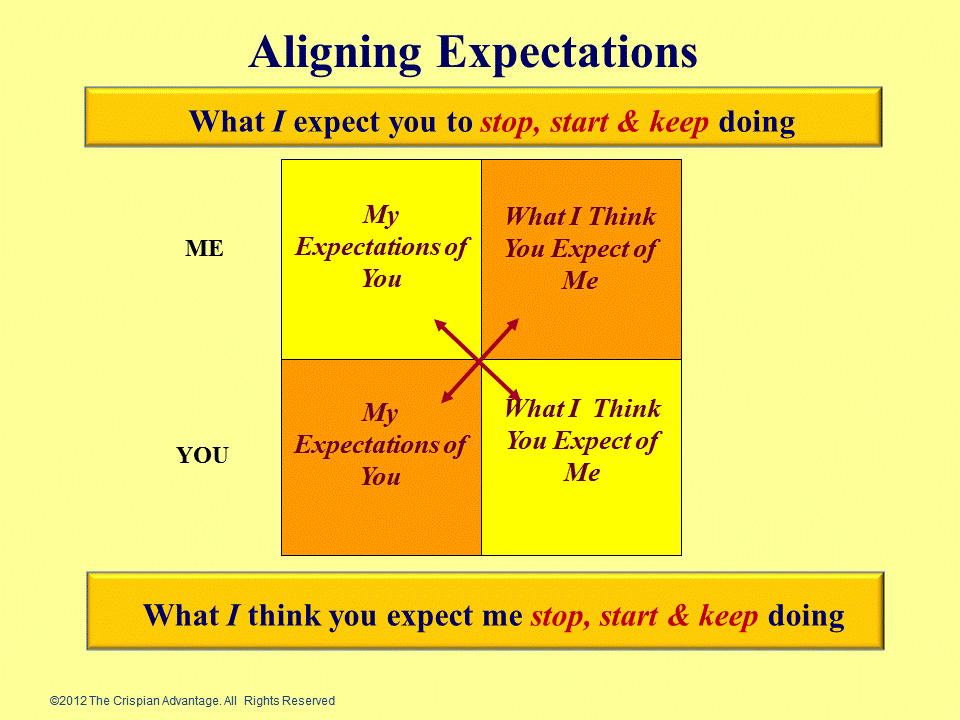
Leading in times of transition is at best a challenge. At worst it can be a leader’s darkest nightmare like two badgers fighting in a sack. Realistic? No, not as bloody, but nevertheless intense. Dealing with such intensity centers on ensuring those leading change are equipped with the stamina and skill to stop culture outmaneuvering such initiatives.
The tension between what leaders want to achieve and their organization’s culture often means that traditional leadership training has not equipped leaders to effectively lead the organization through major changes. Too often previous leadership training and a history of failed change contribute to the tension between the forces for change and those for maintaining the status quo. Unfortunately, as each attempt to use training to improve leadership competence fails, so do the chances of successful change decline.
One reason leadership training lacks impact (no matter how good) is the lack of rigorous and continuous linkage between advancing a specific change and advancing relevant competence. Consequently, leading up to a change, those expected to lead become part of the problem, not the solution. Too often they are unable or unwilling to tackle rising uncertainty and resistance.
Assuming leaders are always managing change with limited resources; leaders have to manage the tension between the three elements of Stop, Start and Continue. After deciding to change, leaders need to identify which groups and individuals are likely to experience unhealthy stress and resistance; then, focus on aligning these people.
This underscores the need for leadership consensus on why and what are we changing. For many survey contributors, leader inconsistency fuels people’s natural resistance. The ever-increasing rate of change demands that leaders give clear and compelling reasons for employees to overcome their feelings of “here we go again”. Unfortunately, too many leaders either ignore, or are unaware that change will be stressful for their peers and employees.
This is the reason so many change and especially training initiatives fail. Such failure then adds toxicity to an already resistant culture. It is why we advocate Aligning Leaders First before implementing any leadership effectiveness project. This leads to outcomes like:
- Shortening change cycles by directly increasing and improving coaching interventions by Leaders and Managers
- Developing a solid foundation for measuring how different change tactics impact staff in different areas.
- Creating a common vocabulary for change and change discussion
- Engaging and developing commitment to make change work.
How can you re-engage managers and develop their leadership competence?
This blog looks at how you can develop both measurable short- and longer-term results based on:
1. Getting People On The Same Page by Aligning People and then;
2. Making Better Use of What You Have by using Action Learning to help managers solving difficult problems while developing their leaders’ skills.
The Value of Getting People on the Same Page – First
There is a wealth of experience showing that any approach to improving effectiveness is seriously flawed if the executive team and middle managers are not aligned. So before any attempt to develop people, especially leaders, you need to ensure that “People are on the Same Page”.
Our latest research underscores how to manage change successfully (Focusing Change to Win by Nick Anderson & Kelly Nwosu, 2012). By surveying 1072 leaders from 19 industry sectors and analyzing their 6000 comments we concluded that successful change needs an Expectations Framework in which leaders are helped to agree and align on what they expect their managers and people to:
- Stop Doing (So that they can start doing new things)
- Start Doing
- Continue Doing
You may think everyone does these three steps; you are probably wrong. At least 70% of the time according to our studies. This survey reinforces these findings. Why is this important? In conditions where these three steps are assumed or glossed over the ambiguity of change is fueled and greater change resistance results. It’s the leader’s blind spot. The leadership spends many hours formulating a change strategy often with incomplete or biased information. Finally, when the plan is set in stone it is announced to those expected to implement the change. They forget or ignore the cardinal rule of successful change:
The Cardinal Rule: Change has to be personal before it can be organizational.
 Getting people on the same page relies on aligning individual and group expectations that develop more specific, objective and measurable ways of working to implement a specific change. It stimulates people to explicitly assess performance expectations of themselves and others. This process:
Getting people on the same page relies on aligning individual and group expectations that develop more specific, objective and measurable ways of working to implement a specific change. It stimulates people to explicitly assess performance expectations of themselves and others. This process:
- Ensures that they are aligned through reciprocated and strategically focused expectations.
- Drives performance discussions between groups and individuals about their specific expectations and assumptions, resulting in:
- Greater commitment to performance criteria against which people will be measured.
- Removing expectations that are not strategically aligned.
- Identifying significant issues for senior management to address to advance
Leaders are confronted by having to specify what they expect of each other and what skills need improved. When this is bounded by a process of developing sound competency definitions there is a marked change in people’s performance language.
This set up of the leadership competency results in robust and more balanced discussions about:
- What’s working?
- What’s not working?
- Why?
The outcome is that leaders and managers start using the new language in their day-to-day interactions and coaching. The specificity of aligning expectations naturally creates a more balanced and common language for addressing competence and skill issues. This lays the foundation for manager’s greater engagement in addressing their own competence issues. It also creates far greater transparency in communicating performance issues with conviction and confidence. This is the very crux of improving effectiveness.
The result is a full analysis of current leadership and organizational alignment issues and which problem areas need tackling for successful change. This analysis includes:
- Articulation of Leaders’ Assumptions against Senior Executives’ Expectations.
- Clear articulation of all organizational expectations.
- Alignment Correction in three functional areas:
- Performance Criteria – Assessment and adaptation of these criteria descriptions to assure peak performance by all people.
- Removal of Unnecessary Activities – Discovery and elimination of non-value added activities from all personnel’s standard routines.
- Issue Assignment and Resolution – Escalating issues to the correct person with an effective amount of authority and influence to handle the problem.
This process begins to define what needs to be done differently; the competencies that are needed to allow change, issues which distract the change from happening, and the degree of increased competence needed within the various departments and functions.
We need to move away from doing the same thing repeatedly and expecting different results, to doing different things targeting different results!
To do this we need to help leaders understand:
• What is expected of them.
• What they can expect from others.
• How well they are strategically aligned with initiatives, purpose and vision.
• How their performance is measured and compensated.
• What they can stop doing.
• What they need to focus on.
• What they should start doing.
• What information and resources can be used to achieve their goals
• How they are going to be supported and coached.
This establishes new metrics for measuring alignment progress between individuals and groups in areas critical to leading more effectively during the change process. Now, leaders are able to clear up major barriers to the change process.
These assessments identify relationship gaps. These gaps create intensity and awareness – the very foundation on which people start to honestly talk about what is expected from them. Of course, these honest conversations clearly expose productivity obstacles which, once identified, can be removed in the second phase, Action Learning to ensure that:
- Change management and coaching are integrated
- People work with the skills, knowledge, and capabilities they have
- Specific learning is delivered at the time of greatest need
- Learners are treated as adults and helped to solve problems
- Change and competence are advanced simultaneously
But, what about training leaders?
It seems obvious but, shouldn’t we give them credit for their experience, knowledge and skills they have gained. Adding leadership concepts and training (no matter how good they are) risks creating resistance and does not change behavior! Conversely, building commitment relies on giving your leaders and managers credit for what they already know, while changing behaviors that do not work. You need to avoid adding new and unnecessarily different language to already cloudy corporate cultures.
Leaders can increase their return on existing investments in people, training, technology and processes by helping them Make Better Use of What You Have.
The Value of Action Learning
When you have people on the same page it becomes clearer which critical and complex problems need to be solved. It also crystallizes the gaps in leader’s competence to lead change. Action Learning is a powerful tool for developing such solutions while developing leaders, building teams and improving performance. Action Learning has helped create new products and services, saved billions of dollars, improved service quality and positively changed organization cultures (Marquardt, Leonard, Freedman & Hill 2009; Boshyk & Dilworth, 2010). Recent surveys by:
- American Society of Training & Development indicates that two-thirds of leadership programs in USA use Action Learning
- Corporate Executive Board (2009) noted that 77% of learning executives identified Action Learning as the top driver of leadership bench strength
- BusinessWeek identified Action Learning as the “latest and fastest growing organizational tool for leadership development” (Byrnes 2005, p.71)
Since Reg Revans developed Action Learning back in the 1940s, there have been many variants but all share:
- Learning through real people resolving real problems in real-time
- Enabling the unique power of solving difficult challenges, developing leaders and organizations at minimal cost
Action Learning is now a prime tool for developing leaders, building teams and improving organizational capabilities. It is based on:
- Making useful progress on solving real world problems and developing practical opportunities
- Giving managers sufficient scope to learn from each other, how best to approach ill-structured challenges to which nobody can, at the outset, suggest any satisfactory solution
- Encouraging management developers to see their missions afresh.
- No longer trying to teach how to manage, but working with senior managers to create conditions in which all managers learn with and from each other in pursuit of a common goal.
This is achieved by setting up Action Learning Teams which sustain a clearer focus on those tactics which have the greatest potential by:
- Defining objectives, appropriate workflow strategies & tactics selected
- Developing sound process maps of what works, improvements and barriers.
- Developing a team understanding of why an improvement should be chosen.
- Articulating Value Propositions for immediate improvements (ROI, Feasibility, etc.).
- Considering internal & external customers and organizational needs.
- Creating solutions based on internal strengths and available resources.
- Ranking decision criteria for competing actions or workflow conflicts.
- Making action agreements to use the technology or stick to a protocol.
- Gathering Evidence for continuing development of people and advancement of process improvements.
Putting it all Together
We’ve explored how getting all leaders and managers on the same page can result in better preparedness for the transition to come. We’ve also demonstrated the value of action learning to build on existing leadership skills to effectively lead major change initiatives.
Leading in transition demands both different and greater skills like:
- Gaining and retaining buy-in
- Developing each person’s role during the transition
- Delegating responsibility, authority, and accountability for every element of the planned change
- Setting-up prompt feedback on status and results of each activity necessary for successful change.
Expectation Alignment and Action Learning are essential tools in the leader’s toolkit, the tools that dramatically improve implementation of strategic change initiatives contributing to improved business performance. Make sure you and your leadership team are prepared to lead in transition the next time your organization tackles a major change.
[contact-form][contact-field label=’Name’ type=’name’ required=’1’/][contact-field label=’Email’ type=’email’ required=’1’/][contact-field label=’Website’ type=’url’/][contact-field label=’Comment’ type=’textarea’ required=’1’/][/contact-form]
